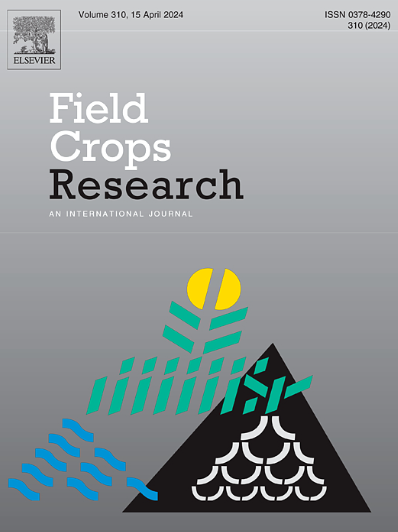Efficient fertilization pattern for rice production within the rice-wheat systems
IF 5.6
1区 农林科学
Q1 AGRONOMY
引用次数: 0
Abstract
Context
Rice is a staple food for nearly half of the global population. Traditional nitrogen (N) fertilization practices, characterized by high inputs and frequent applications, face increasing challenges related to low N use efficiency (NUE) and rising labor costs.
Research question
Previous studies have highlighted the benefits of controlled-release blended fertilizers (CRBF) for enhancing rice production. While limited research has been conducted on the effects of CRBF with different fertilization techniques and their applicability within rice-wheat systems.
Methods
A three-year field experiment was conducted at two sites with contrasting soil fertility levels. Six treatments were evaluated: broadcast conventional fertilization of urea (BCF), broadcast conventional fertilization of urea with a 25 % reduction in N (BRF), broadcast fertilization of CRBF with a 25 % reduction in N (BBF), whole-layer fertilization of CRBF with a 25 % reduction in N (WBF), side-deep fertilization of CRBF with a 25 % reduction in N (SBF), and a control without N fertilization.
Results
Compared to BCF, SBF increased rice yield by 3.2–8.8 % primarily due to a 5.1–6.7 % increase in panicle numbers, and all CRBF treatments enhanced NUE by 27.6–60.8 % with SBF exhibiting the highest. Notably, SBF improved rice yield and NUE by 6.0–7.0 % and 19.4–25.2 % compared to other CRBF treatments in low-fertility site, respectively, while no significant differences were observed among CRBF treatments in high-fertility site. This pattern reflects the differing responses of rice growth and soil N availability to fertilization patterns under varying soil fertility conditions. Our structural equation model results indicate that fertilization patterns primarily influence rice yield by affecting soil NH4+-N levels and subsequently altering root growth. Economic analysis revealed that SBF resulted in a 37.2–40.1 % increase in net income compared to BCF, primarily due to reduced labor costs and improved yields, with smaller differences among CRBF treatments in high-fertility site.
Conclusions
CRBF emerges as a viable alternative to conventional N fertilization, effectively delivering high rice yields and enhanced economic returns across sites with varying soil fertility. SBF optimizes N supply and boosts rice production, yielding significant increases in both yield and NUE, particularly in low-fertility environments.
Implications
The findings of this study offer a novel perspective on achieving high yields and efficient fertilization strategies in rice cultivation within rice-wheat systems, potentially guiding future agricultural practices toward improved sustainability and productivity.
稻麦系统中水稻生产的有效施肥模式
大米是全球近一半人口的主食。传统氮肥投入大、施用频繁,面临氮素利用率低和劳动力成本上升的挑战。以前的研究强调了控释混合肥料(CRBF)对提高水稻产量的好处。不同施肥技术对CRBF的影响及其在水稻-小麦系统中的适用性研究有限。方法在两个不同土壤肥力水平的试验点进行为期3年的田间试验。对6个处理进行了评价:常规施肥尿素(BCF)、常规施肥尿素减氮25% % (BRF)、常规施肥CRBF减氮25% % (BBF)、全层施肥CRBF减氮25% % (WBF)、侧深施肥CRBF减氮25% % (SBF)和不施肥对照。结果SBF处理与BCF处理相比,水稻产量提高了3.2 ~ 8.8 %,主要是由于穗数增加了5.1 ~ 6.7 %;CRBF处理的氮肥利用率提高了27.6 ~ 60.8 %,其中SBF处理的氮肥利用率最高。在低肥力地,SBF处理的水稻产量和氮肥利用率分别比其他处理提高了6.0 ~ 7.0 %和19.4 ~ 25.2 %,而在高肥力地,不同处理间差异不显著。这一模式反映了不同土壤肥力条件下水稻生长和土壤氮有效性对施肥模式的不同响应。结构方程模型结果表明,施肥方式主要通过影响土壤NH4+-N水平进而改变根系生长来影响水稻产量。经济分析表明,在高肥力地,SBF处理的净收入比BCF处理提高了37.2-40.1 %,主要是由于降低了人工成本和提高了产量,而CRBF处理之间的差异较小。结论scrbf是传统氮肥的可行替代方案,可在不同土壤肥力条件下有效提高水稻产量和经济效益。SBF优化了氮素供应,提高了水稻产量,产量和氮肥利用效率显著提高,特别是在低肥力环境中。本研究结果为在稻麦系统中实现水稻高产和有效施肥策略提供了新的视角,可能指导未来的农业实践提高可持续性和生产力。
本文章由计算机程序翻译,如有差异,请以英文原文为准。
求助全文
约1分钟内获得全文
求助全文
来源期刊

Field Crops Research
农林科学-农艺学
CiteScore
9.60
自引率
12.10%
发文量
307
审稿时长
46 days
期刊介绍:
Field Crops Research is an international journal publishing scientific articles on:
√ experimental and modelling research at field, farm and landscape levels
on temperate and tropical crops and cropping systems,
with a focus on crop ecology and physiology, agronomy, and plant genetics and breeding.
 求助内容:
求助内容: 应助结果提醒方式:
应助结果提醒方式:


